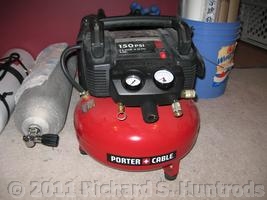Jetsam Baby Booster
I decided early on that I wanted to boost my own gas once I bought a rebreather - I wanted the control over my mixes plus the convenience of being able to fill anytime.
My instructor Danny Huton had the HI booster and had good things to say about it, but it comes "bare" so that you must build it into a boosting system yourself. In the end, after much internet searching and reading on forums like Rebreather World, I decided to purchase the Jetsam Baby Booster. One great thing about Jetsam is that it's located in Vancouver, just across the water from where I am on Vancouver Island. I also knew some people that had the Jetsam and had good things to say about it.
I called up Jetsam, and quickly the booster was here. It really is a nice piece of gear. While waiting for the booster to arrive, I went in to Nanaimo and leased a couple of K's of Oxygen from Praxair for a very reasonable fee. Now I needed fittings to allow me to connect the Jetsam's 300Bar DIN fitting to an O2 bottle. NE Scuba Supply to the rescue. They had just the fill whip on their web site, so I called and asked for just the DIN-to-O2 and O2-to-He fittings shown. They were happy to sell them to me, and they came quickly. (I also picked up a very nice IP guage from them that I really like.)
As an aside, after much searching and calling and visiting, I found that Canada seems to have it's head buried in the sand when it comes to high pressure (HP) fittings. Gas supply and welding shops sell regulators for He and O2, but if you mention that you want to do anything else (i.e. just fittings), they cry "we can't talk to you because of Transport Canada regulations!!! We can't sell you ANYTHING!!!". Eventually I found that (at least to me), the only place to purchase HP fittings is either California, Eastern US, or Florida. Weirdness.
Once I had my baby booster and O2 fittings, I started to transfill and boost diluent and O2. Diluent came from my twin PST 104's, O2 from my K's. I closed the manifold isolator and used one side to drive the booster, and the other side as diluent supply. This worked well, but was a nuisance. Later I grabbed my 80cf bailout cylinder and used it to drive the booster, with diluent coming from the twins. This worked well, but still you had to fill the cylinders somewhat frequently, plus you had to watch the drive gas. I found that I was always boosting to 2000psi or maybe 2500psi just to conserve drive gas.
From the start, I wanted to get a small oilless compressor to drive the booster. Jetsam disavowed any knowledge of anyone ever doing this (liability?), but Rebreather World had numerous posts of this being done successfully. The problem I faced at the time (June-August 2007) was that it turned out to be impossible to get a 150 psi compressor anywhere. DeWalt had one listed, but no-one would stock it. I tried ordering it, but the stores would tell me that it was discontinued (it was not, as DeWalt confirmed). Eventually I just gave up and waited.
Then, in late August, the fall flyers started coming out with 150psi compressors EVERYWHERE. I drove in to Home Depot and picked up a nice DeWalt D55141 2gallon 150 psi compressor as I loved the form factor, plus it was the cheapest one there. I bought the $40.00 extended warranty (+2 years) "just in case". After all, it IS a moving parts machine. I also bought some quick disconnect fittings and a hose. Later I bought some "hi-flow" fittings and assembled the hose. The "hi-flow" fittings leaked, so I tossed them and ended up using normal quick disconnect fittings.
For the booster drive, I tried calling around to get a fitting to adapt the LP inflation hose to the 1/4" NPT fittings of the compressor, but again hit that brick wall of "huh?". I did have a 1/4" NPT quick-disconnect fitting with a barbed end, so I ended up just cutting the regulator attachment off the LP hose, adding a hose clamp, inserting the barbed fitting and tightening it all up. Then add a female thread 1/4" NPT male quick-disconnect, and it's complete. Works like a charm, too. The booster is almost complete - all I want to do is add a water trap to prevent condensation getting into the booster and I'll be done. As it is, I can easily boost to 3000 psi using 1500 psi supply gas. The booster works very well, and I'm totally happy with the setup.
Below are some pictures of my setup - the compressor, the baby booster kit complete with my O2 and He fittings, plus the LP inflator hose. A couple of close-ups of the LP hose's quick-disconnect and one of the fitting complete the set.
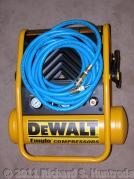
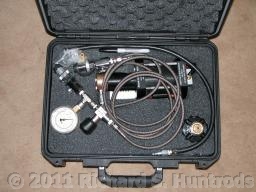
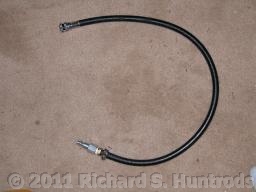
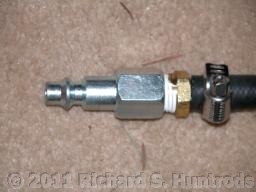
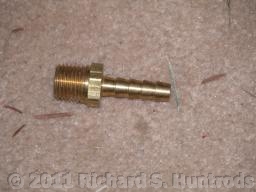
Update - September 2007
I was not happy with the condensation coming out of the compressor at the end of a long boost, so I purchased a small water separator from Home Depot together with a set of quick-connect fittings. This allows me to place the separator in-line just before the LP inflate hose that goes to the booster. It works great, and keeps condensation out of the booster.

Update - March 2008
Ever since adding the water trap to the Dewalt compressor line, I wanted to add some additional filtration to the system. On Feb 7, I purchased a "paint sprayer filter" and a couple of quick connects. Adding this to the system has not changed the ability of the compressor to drive the booster and now gives me some additional peace of mind. With the quick connects, I can add the filters or omit them as necessary.
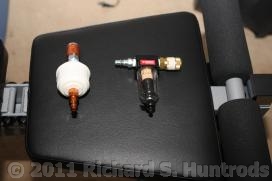
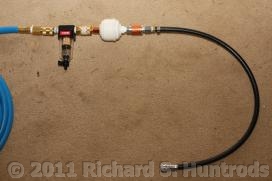
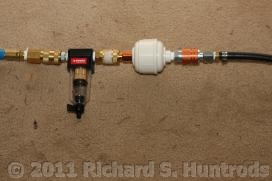
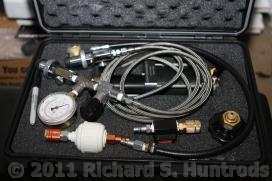
Update - March 2010
Well, I've been told that oil-less compressors are a disposable item, and this one has turned out to be true to form. The compressor started putting out a foul electrical odor on the latest boost cycle, then quit completely. I allowd it to cool off and bled the system down, and it started again but was putting out a lot of sparks while it ran, so I shut it off.
I had purchased an extended warranty for the little DeWalt compressor, so contacted the company and arranged to take it in for service. After a week in the shop, the report came back - the motor was toast. I was also told that it's more money to fix than the compressor is worth, so I was given a full refund of the purchase price. Not too bad! However, tallying up the numbers indicated the compressor ran under 30 hours since purchase - not great durability. I doubt I'll purchase the same unit again.
One thing I did notice about the whole boosting process is that while the compressor was dying, it only could manage 100 psi max pressure to drive the booster, yet the booster was able to give me 2400 psi without any real problem. I think once I have a new compressor I will reduce the drive pressure from the 150 psi I was using to something around 120 or even 110 - which should reduce wear on the new compressor.
Update - June 2010
I have been searching for a decent cheap oil-less compressor since the DeWalt died. On thing I have concluded is that the DeWalt, with a 2 gal. tank, just didn't have enough capacity to run the booster at higher boost pressures - even though I only boost to 2400 psi now.
After much looking, and waiting for a good sale, I found the perfect deal. A Porter-Cable 150 psi, 6 gal. compressor complete with two nail guns. As I needed a nail gun to install the new bedroom floor, this was perfect, and at a good price for the whole kit. It even came with a quick-disconnect hose. After an inital test, I am quite happy with my purchase
